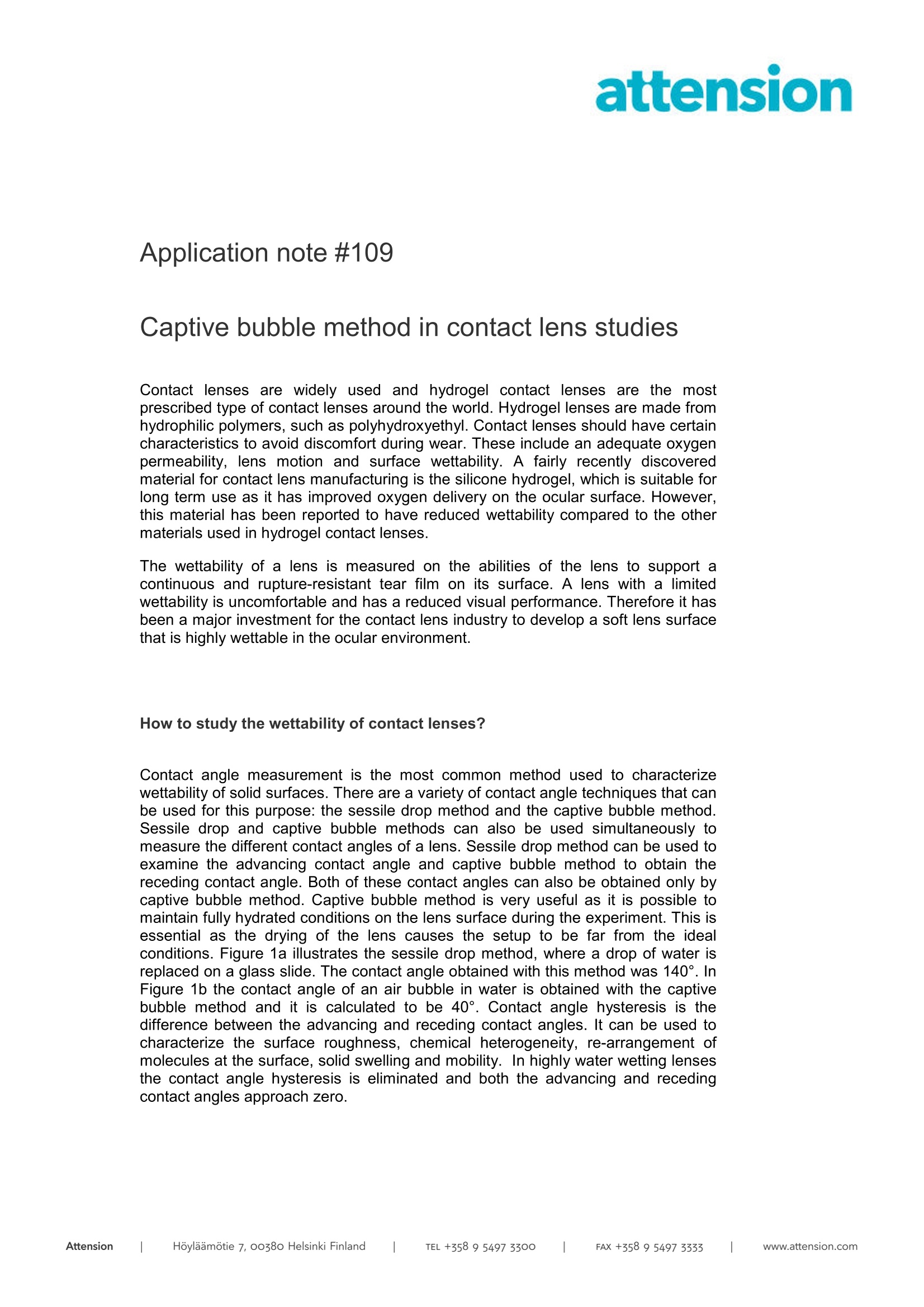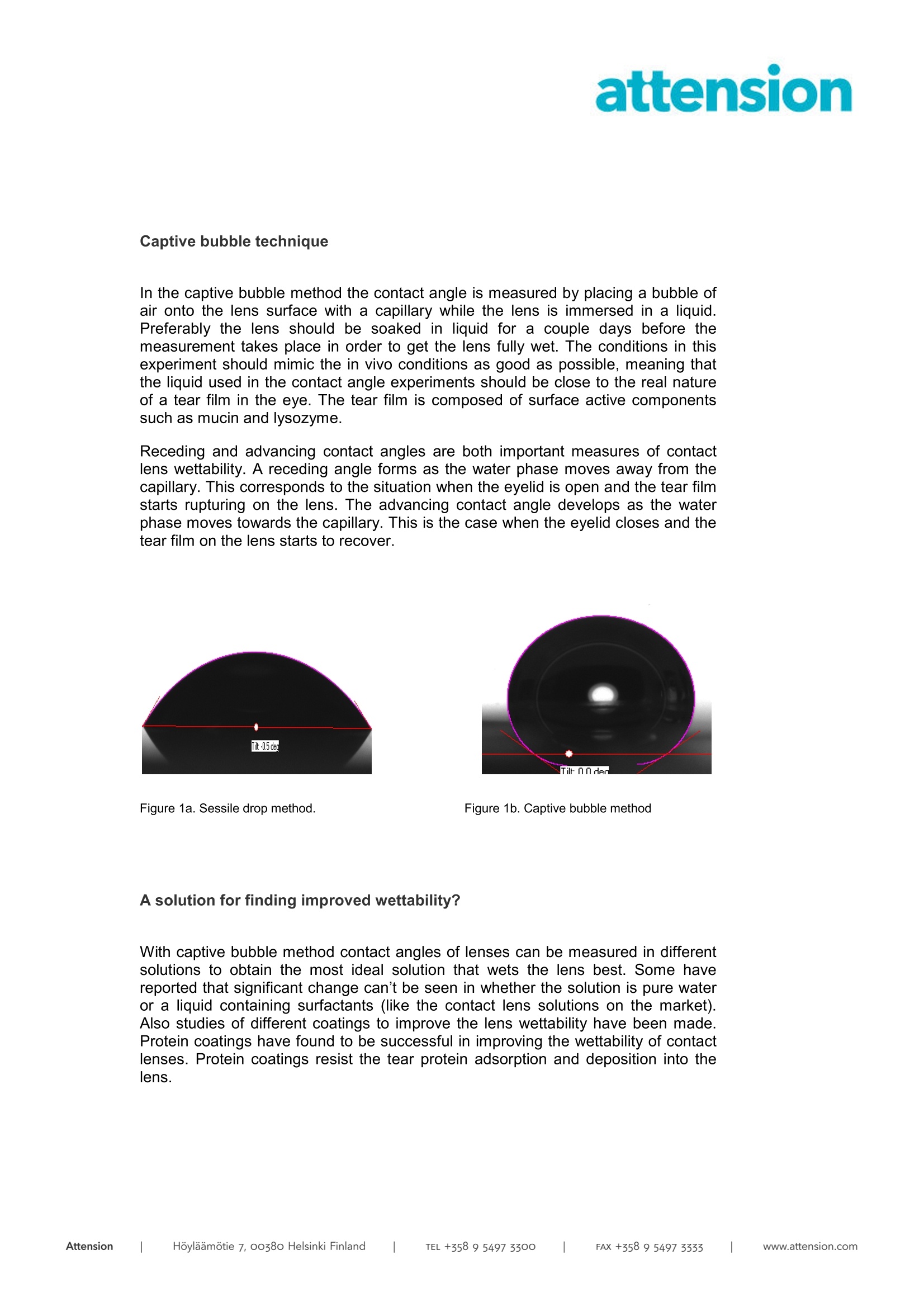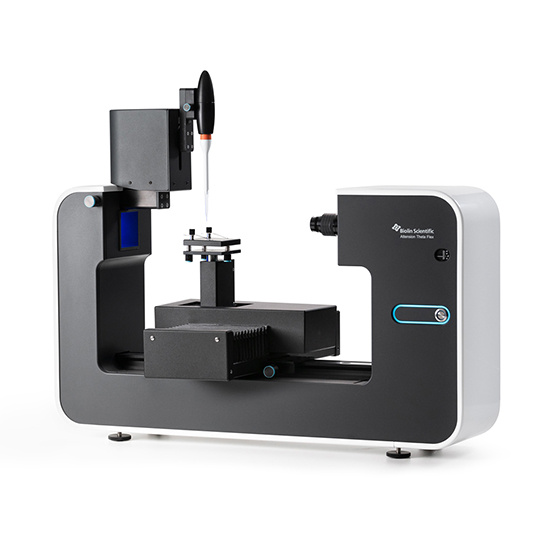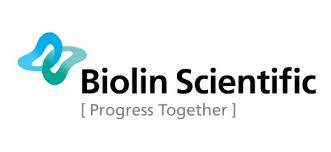方案详情
文
隐形眼镜表面润湿度对于佩带舒适性有很大影响,表面接触角是测试固体润湿度的方法之一。本文采用光学接触角仪对隐形眼镜在水中的表面气泡吸附角进行了测试。
方案详情

Application note #109 Captive bubble method in contact lens studies Contact lenses are widely used and hydrogel contact lenses are the mostprescribed type of contact lenses around the world. Hydrogel lenses are made fromhydrophilic polymers, such as polyhydroxyethyl. Contact lenses should have certaincharacteristics to avoid discomfort during wear. These include an adequate oxygenpermeability, lens motion and surface wettability. A fairly recently discoveredmaterial for contact lens manufacturing is the silicone hydrogel, which is suitable forlong term use as it has improved oxygen delivery on the ocular surface. However,this material has been reported to have reduced wettability compared to the othermaterials used in hydrogel contact lenses. The wettability of a lens is measured on the abilities of the lens to support acontinuous and rupture-resistant tear film on its surface. A lens with a limitedwettability is uncomfortable and has a reduced visual performance. Therefore it hasbeen a major investment for the contact lens industry to develop a soft lens surfacethat is highly wettable in the ocular environment. How to study the wettability of contact lenses? Contact angle measurement is the most common method used to characterizewettability of solid surfaces. There are a variety of contact angle techniques that canbe used for this purpose: the sessile drop method and the captive bubble method.Sessile drop and captive bubble methods can also be used simultaneously tomeasure the different contact angles of a lens. Sessile drop method can be used toexamine the advancing contact angle and captive bubble method to obtain thereceding contact angle. Both of these contact angles can also be obtained only bycaptive bubble method. Captive bubble method is very useful as it is possible tomaintain fully hydrated conditions on the lens surface during the experiment. This isessential as the drying of the lens causes the setup to be far from the idealconditions. Figure 1a illustrates the sessile drop method, where a drop of water isreplaced on a glass slide. The contact angle obtained with this method was 140°. InFigure 1b the contact angle of an air bubble in water is obtained with the captivebubble method and it is calculated to be 40°. Contact angle hysteresis is thedifference between the advancing and receding contact angles. It can be used tocharacterize the surface roughness, chemical heterogeneity, re-arrangement ofmolecules at the surface, solid swelling and mobility. In highly water wetting lensesthe contact angle hysteresis is eliminated and both the advancing and recedingcontact angles approach zero. Captive bubble technique In the captive bubble method the contact angle is measured by placing a bubble ofair onto the lens surface with a capillary while the lens is immersed in a liquid.Preferably the lens should be soaked in liquid for a couple days before themeasurement takes place in order to get the lens fully wet. The conditions in thisexperiment should mimic the in vivo conditions as good as possible, meaning thatthe liquid used in the contact angle experiments should be close to the real natureof a tear film in the eye. The tear film is composed of surface active componentssuch as mucin and lysozyme. Receding and advancing contact angles are both important measures of contactlens wettability. A receding angle forms as the water phase moves away from thecapillary. This corresponds to the situation when the eyelid is open and the tear filmstarts rupturing on the lens. The advancing contact angle develops as the waterphase moves towards the capillary. This is the case when the eyelid closes and thetear film on the lens starts to recover. Figure 1a. Sessile drop method. Figure 1b. Captive bubble method A solution for finding improved wettability? With captive bubble method contact angles of lenses can be measured in differentsolutions to obtain the most ideal solution that wets the lens best. Some havereported that significant change can’t be seen in whether the solution is pure wateror a liquid containing surfactants (like the contact lens solutions on the market).Also studies of different coatings to improve the lens wettability have been made.Protein coatings have found to be successful in improving the wettability of contactlenses. Protein coatings resist the tear protein adsorption and deposition into thelens. References Carole Maldonado-Codina, Philip B. Morgan: In vitro water wettability of siliconehydrogel contact lenses determined using the sessile drop and captive bubbletechniques (Published online 14 May 2007 in Wiley InterScience) Lily Cheng, Susan J. Muller, Clayton J. Radke: Wettability of silicone-hydrogelcontact lenses in the presenve of tear-film components (Current Eye Research,2004, Vol. 28, No. 2, pp. 93-108) Meng C. Lin, Tatyana F. Svitova: Contact lenses wettability in vitro: Effect ofsurface-active ingredients (Optom Vis Sci 2010, 87, 440-447) AttensionTEL +oylaamotie , Helsinki Finlandwww.attension.comFAX + TEL +AX +ww.attension.comHoylaamotie , Helsinki Finland
确定



还剩1页未读,是否继续阅读?
瑞典百欧林科技有限公司为您提供《隐形眼镜中表面润湿度检测方案(接触角测量仪)》,该方案主要用于眼镜中表面润湿度检测,参考标准--,《隐形眼镜中表面润湿度检测方案(接触角测量仪)》用到的仪器有Attension Theta Flex 光学接触角仪、Theta Lite 光学接触角仪
相关方案
更多











